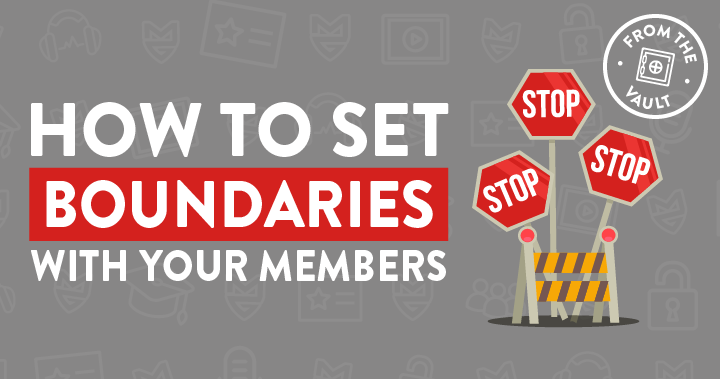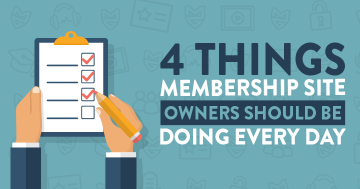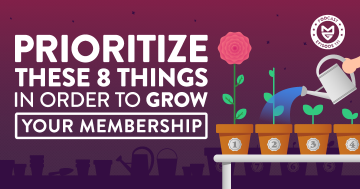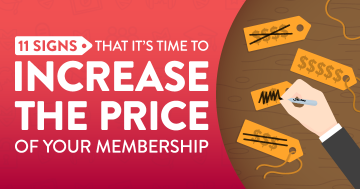New membership site owners are often afraid that, as soon as their member numbers start to increase, they’re going to be overrun by people clamouring for their attention.
Every hour of the day will be spent fighting against the tide of emails, with any semblance of the life they once had dragged to the depths with an inbox-sized weight tied to its ankle.
How can membership site owners stop their lives being overrun by their members?
Is it possible to walk the line between contactable and shut off?
Having a strategy that helps you provide your members with a five-star service, whilst also respecting your time, space, and life is essential.
Reality check
The likelihood that your members are going to spam your inbox night and day is lower than low.
It’s not actually going to happen!
Putting boundaries in place is healthy, sensible, and right.
But it doesn’t mean you should use it as an excuse to close yourself off because you want to shut down and keep yourself protected and have a quiet life.
If that’s what you’re hoping for, it’s worth asking yourself whether starting a membership site is the right move for you.
Running a membership – especially a successful one – will always involve work!
But it’s work that’s on your terms.
It’s impossible to run a membership without contact with your members.
They will reach out to you and any successful membership site owner will respond.
That’s not to say that you can’t set boundaries.
You can be the one to set the terms.
More opportunities mean less chance of overwhelm
This sounds counterintuitive, but we have found that having more channels for communication has actually reduced how much people contact us.
Once you analyze it a bit further, though, it does make sense.
When people know that they don’t have to try hard to reach you – that you are available via a live chat, an email, and social channels – you take the urgency out of the equation.
If they know that they can get in touch with you wherever and however they need, it kills the idea that they have to compete for your attention.
On the other hand, when you make it difficult for people to get in touch with you, it becomes a more pressing issue.
It’s a matter of scarcity vs. abundance.
People will reach out because they want to know that you will respond when they have a problem, not because they have a problem there and then.
While it may seem counterintuitive to open up more channels of communication for your members in an attempt to reduce contact overwhelm, we – and our members – have found it to be surprisingly effective.
Set your ground rules and expectations
Whilst it’s important to be contactable and visible – more than you might even want to be! – it is even more important that you establish some ground rules.
These ground rules and boundaries can take many different forms and have to suit you and the way you run your membership.
Some of the most popular approaches include:
- If you have a contact form or a messaging app, make your response time clear. Whether you’ll get back to them in 12, 24, or 48 hours (however long, and whatever timeframe suits you), nobody should be in a position where they send you a message and they have no idea of when to expect a response. Without this, your members will have no frame of reference for whether waiting 24 hours is a long time or the norm!
- Use a ticketing system like Helpscout to set up automatic responses to every enquiry. You can use these automated messages to let every enquirer know that their message has been received, when they can expect a response, and even to share some FAQ answers. Take a look at our other suggestions for tools and resources.
- List your hours of operation for your membership on your site – 999 out of every 1,000 members behave respectfully and reasonably, but if you don’t tell them that you don’t work weekends or evenings, they won’t know that they’re overstepping their bounds if they contact you then!
As you can see, setting and managing expectations is not just good for you, but your members too.
How to handle members misusing your communication channels
You will sometimes get people using your communications channels in ways that you don’t want.

No matter how firm your boundaries, no matter how hard you’ve worked to make the ground rules clear, people will sometimes cross them.
One of the most common instances of this involves members contacting you privately for advice – trying to get a private consultation, in effect.
It’s important that you take time to channel those inquiries to the right place.
If someone’s asking you lots of specifics, trying to get private consultation by the back door, then it’s down to you to channel those enquiries elsewhere.
Don’t be dismissive or horrible about it, but be firm in the fact that your support email isn’t a workaround for them to get a 1-on-1 consultation.
Usually, this means channelling them towards your forums.
If you haven’t got one, take a look at our guide on How to Add an Online Forum to your Membership Website.
If this kind of issue comes up regularly, then it’s worth thinking about how you can respond in a way that will benefit everyone.
Are you able to turn these miscommunications – these overstepped boundaries – into useful content for your member base?
- Run a live member Q&A call, where people can submit questions in advance or ask live. That way, if somebody does send you a message privately, you can channel them towards the details for submitting a question.
- Create a member feedback process and incorporate it into your offering. Instead of batting away ad hoc messages, you could include a ‘once per month’ feedback session for your members
If you’re giving in-depth answers to questions in private, then you’re actually doing a disservice to other members who would benefit from seeing that answer in a public discussion.
People pay for your expertise, and it should be distributed equally and fairly.
Boundaries benefit everyone
Setting boundaries with your members isn’t about cutting yourself off or refusing to interact with your community, it’s about shaping your interactions in a way that works for you and your member base as a whole.
Nobody wins if you lose.
But when you’re happy, it’s pretty likely that your members are going to be happy too.






